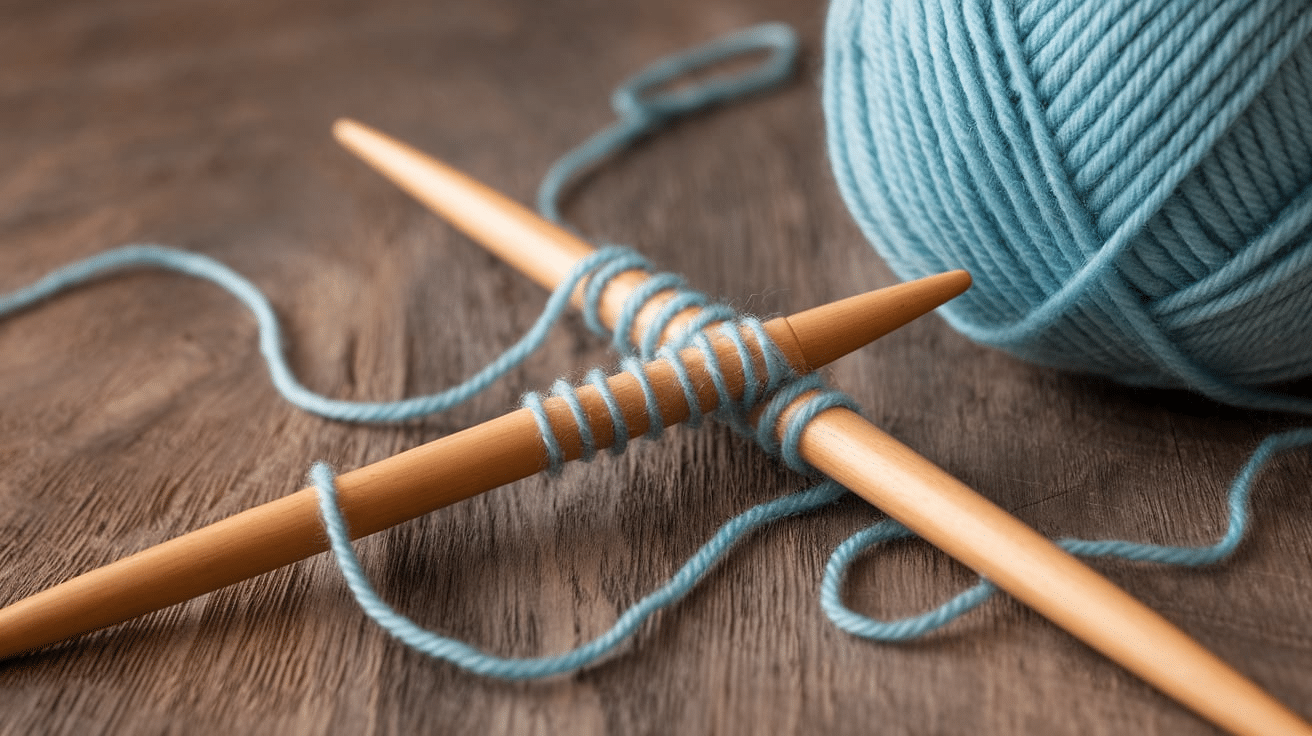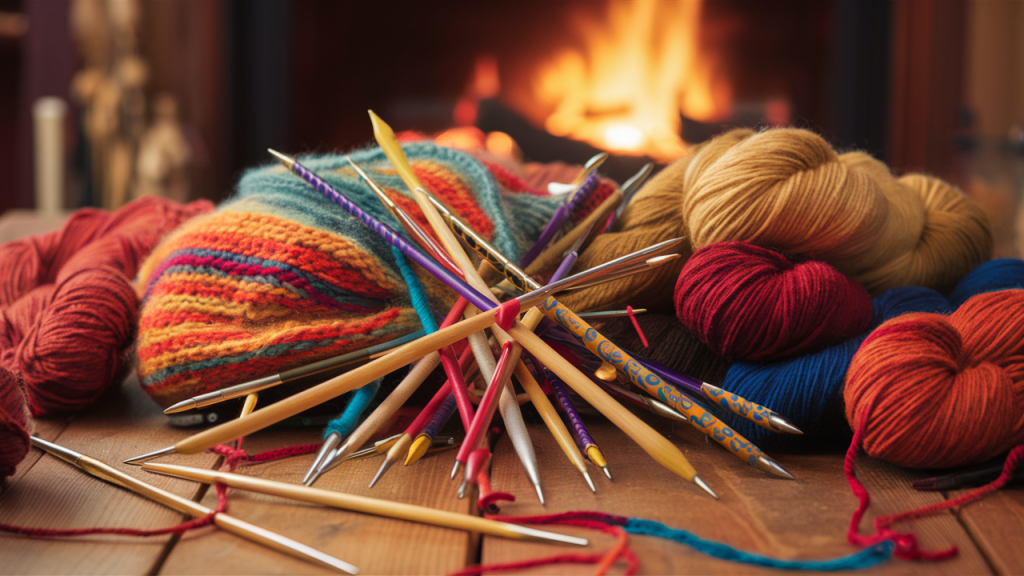Knitting needles come in different sizes, and picking the right one can make a big difference in your project. If you’ve ever looked at a pattern and felt confused by the numbers, you’re not alone.
Needle sizes are measured in different ways, depending on where you live. The US, UK, and metric systems all have their own way of labeling them, which can get a little tricky.
Using the wrong size needle can change the look of your stitches and even affect the size of your finished project. That’s why it’s important to understand how needle sizes work and how to convert them.
In this guide, I’ll help break this down in a simple way. I’ll also include a handy knitting needle size chart to help you find the right size every time.
Understanding Knitting Needle Sizes

Knitting needle sizes can be confusing at first, but once you get the hang of them, they make a lot more sense. Different countries use different numbering systems, which is why you might see multiple sizes listed on a pattern or a needle package. Let’s go over the three main ways knitting needles are measured.
1. Metric System (mm)
- The metric system is the simplest way to measure knitting needles because it tells you the exact thickness of the needle in millimeters.
- This system is used worldwide, including in Europe, and many knitting patterns.
- For example, a 4 mm needle is always 4 mm thick, no matter where you buy it.
2. US Needle Sizes
- In the United States, knitting needles are labeled with numbers instead of millimeters.
- The sizes start small, like 0 or 1, and get larger as the needles get thicker. A US size 8 needle is thicker than a US size 2.
- The tricky part is that these numbers don’t match the metric sizes exactly, so you often need a conversion chart.
3. UK Needle Sizes
- The UK system is the opposite of the US system. In this system, bigger numbers actually mean smaller needles.
- So, a UK size 14 needle is much thinner than a UK size 5.
- This can be confusing if you’re switching between patterns from different countries, which is why a conversion chart is so helpful.
Why Needle Sizes Matters
The size of your knitting needles affects how tight or loose your stitches are. Bigger needles create looser stitches, while smaller needles make tighter stitches. If you use the wrong needle size, your project might end up too big or too small.
Most knitting patterns will tell you which needle size to use, but it’s always a good idea to knit a small test swatch first. This helps you check if your stitches match the pattern’s gauge. If your stitches are too tight, try using a bigger needle. If they’re too loose, switch to a smaller one.
Understanding knitting needle sizes makes choosing the right one easier and helps you get better results in your projects.
Knitting Needle Size Conversion Chart
Knitting needle sizes can be tricky because different countries use different systems. If you’ve ever come across a pattern that lists a needle size you don’t recognize, a conversion chart can help.
To make things easy, I’ve put together a simple conversion chart below.
| Metric (mm) | US Size | UK Size |
|---|---|---|
| 2.0 | 0 | 14 |
| 2.25 | 1 | 13 |
| 2.5 | 1.5 | – |
| 2.75 | 2 | 12 |
| 3.0 | – | 11 |
| 3.25 | 3 | 10 |
| 3.5 | 4 | – |
| 3.75 | 5 | 9 |
| 4.0 | 6 | 8 |
| 4.5 | 7 | 7 |
| 5.0 | 8 | 6 |
| 5.5 | 9 | 5 |
| 6.0 | 10 | 4 |
| 6.5 | 10.5 | 3 |
| 7.0 | – | 2 |
| 7.5 | – | 1 |
| 8.0 | 11 | 0 |
| 9.0 | 13 | 00 |
| 10.0 | 15 | 000 |
| 12.0 | 17 | – |
| 15.0 | 19 | – |
| 20.0 | 36 | – |
Having a size chart like this makes it easier to find the right needle for your project. If you’re working with a pattern from another country, check this chart to match the needle size to what you have. You can also print this chart or save it for quick reference while knitting.
How to Determine Your Needle Size
If you’ve ever found an old knitting needle without a size label or felt confused about which size to use, you’re not alone. Knitting needles come in different sizes, and figuring out the right one is important for getting the best results in your project. Here are some simple ways to check your needle size.
1. Use a Needle Gauge Tool
A needle gauge is a small tool with different-sized holes that help you measure your knitting needles. Just slide the needle into the holes until you find the one that fits perfectly. The size next to that hole is your needle size. This is the easiest way to check if your needles don’t have markings.
2. Check the Needle Itself
Many knitting needles have their size printed or engraved on them. On metal or plastic needles, you might see the size written near one end. Wooden needles sometimes have the size burned into the surface. If the numbers have worn off, a needle gauge will be your best option.
3. Look at the Packaging or Compare to Another Needle
If you still have the original packaging, the size will be listed there. Keeping your needles in their original case or using labeled storage can help you find the right size faster. You can compare your needle to one that you know the size of. Lay them side by side and check if they match in thickness. While this method isn’t perfect, it can give you a rough idea.
Using the right needle size helps your stitches come out even and keeps your project from turning out too big or too small. If you’re following a pattern, always check the recommended needle size and adjust if needed.
Choosing the Right Needle Size
Picking the right knitting needle size is just as important as choosing your yarn. The size of your needles affects how your stitches look, how big your project turns out, and how easy it is to work with your yarn. Some simple tips to help you choose the right size are:
1. Follow the Pattern Recommendation: Most knitting patterns will tell you which needle size to use. This is a great place to start, but keep in mind that everyone knits a little differently.
2. Match Needle Size to Yarn Weight: Yarn labels often suggest a needle size that works best with that yarn. Thicker yarns need bigger needles, while thinner yarns need smaller ones. Here’s a quick guide:
- Lace yarn – Use very small needles (1.5 mm to 2.25 mm).
- Sock/Fingering yarn – Small needles (2.25 mm to 3.25 mm).
- DK yarn – Medium needles (3.75 mm to 4.5 mm).
- Worsted yarn – Medium to large needles (4.5 mm to 5.5 mm).
- Chunky/Bulky yarn – Large needles (5.5 mm to 8 mm).
- Super bulky yarn – Extra-large needles (8 mm and up).
3. Knit a Swatch: Before starting a project, it’s a good idea to knit a small swatch. This helps you check if your stitches match the pattern’s gauge. If your stitches are too tight, try a bigger needle. If they’re too loose, go smaller.
4. Think About Fabric Texture: The needle size you choose affects how your fabric looks and feels. Bigger needles create loose, airy stitches, while smaller needles make tighter, firmer fabric.
5. Adjust for Comfort: If a needle size feels uncomfortable to use, try going up or down a size. Some knitters find that larger needles are easier to hold, while others prefer smaller ones for precision.
Choosing the right needle size makes a big difference in your knitting. By following these tips, you’ll get the best results for every project!
Conclusion
Choosing the right knitting needle size doesn’t have to be confusing. Once you understand how different sizing systems work and how needle size affects your stitches, it becomes much easier to pick the right one for your project.
If you’re following a pattern, matching your yarn, or knitting a swatch to check your gauge, using the right needle size will help your knitting turn out just the way you want.
A knitting needle size chart is a great tool to have on hand, especially if you work with patterns from different countries. It helps you quickly find the right size without guessing.
The best way to get comfortable with needle sizes is through practice. Try out different sizes with different yarns and see how they change the feel of your knitting. The more you experiment, the easier it will be.
Frequently Asked Questions
Why do knitting needle sizes vary in different countries?
Different countries use different measurement systems. The US sizes use numbers, the UK sizes are numbered in reverse (larger numbers mean smaller needles), and the metric system measures the actual diameter in millimeters.
Are metal, wood, and plastic needles all the same size?
Yes, but the material can change how they feel when knitting. Some knitters prefer wood for better grip, while others like metal for smoother movement.
What’s the best needle size for beginners?
A medium size like US 8 (5mm) is great for beginners because it works well with many types of yarn and is easy to handle.
Do different needle brands have slightly different sizes?
Some brands may have small differences, but they’re usually close enough that it won’t affect your knitting much. Always check with a gauge tool if you’re unsure.









